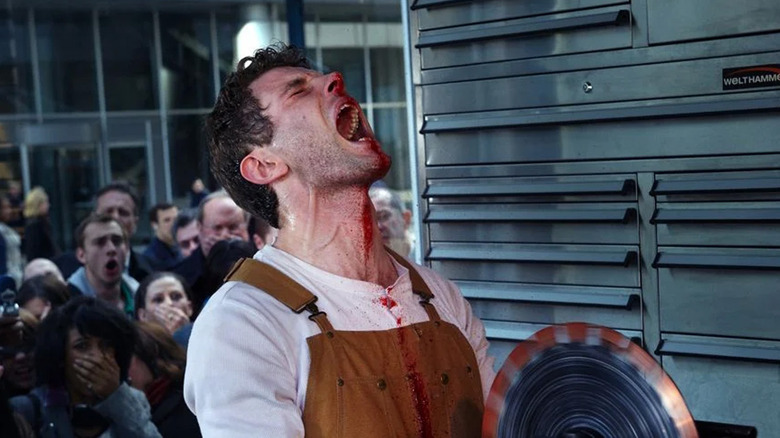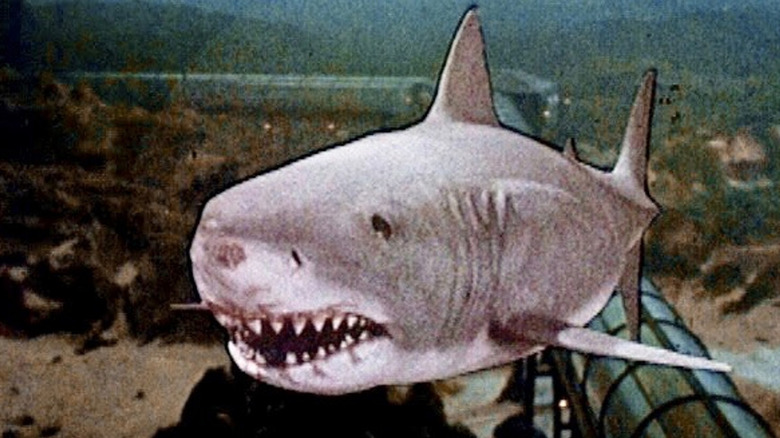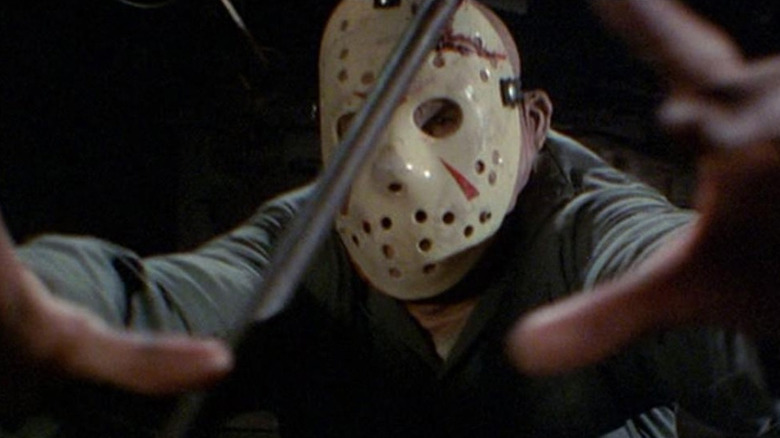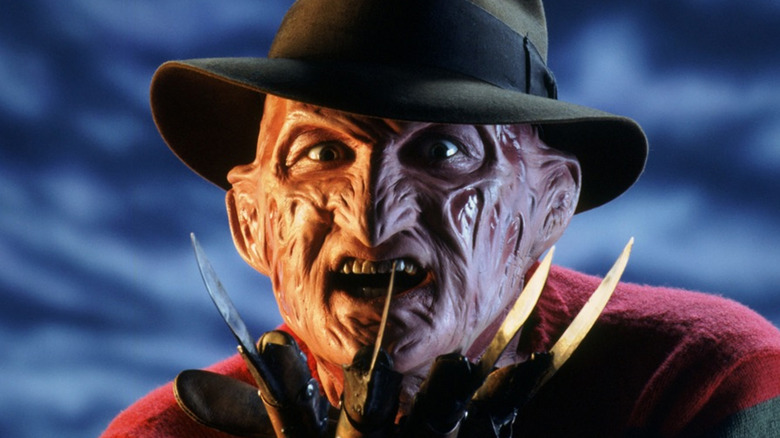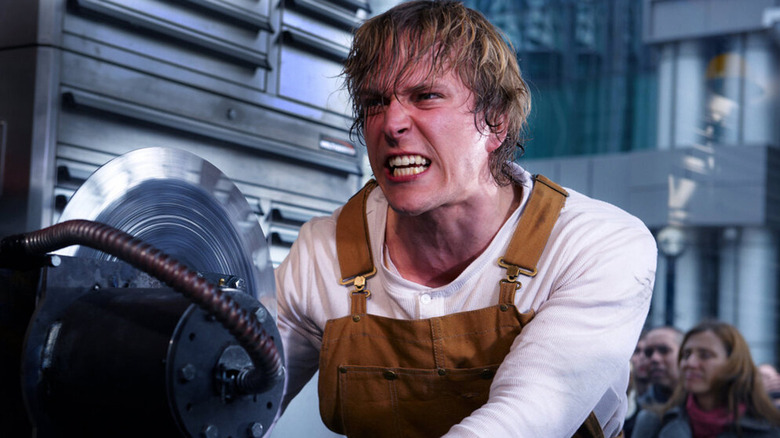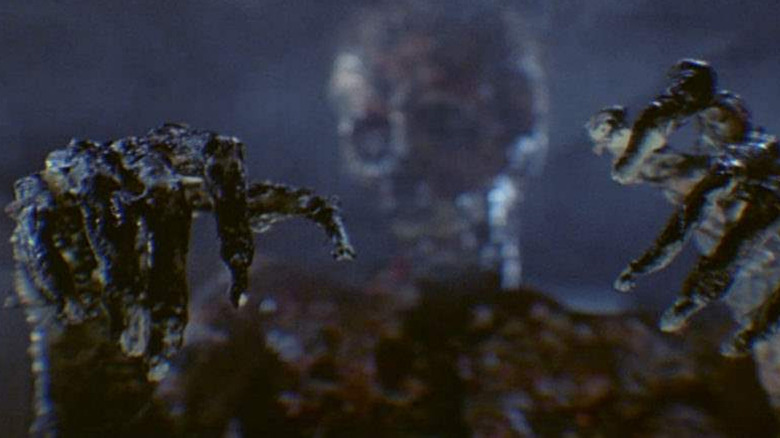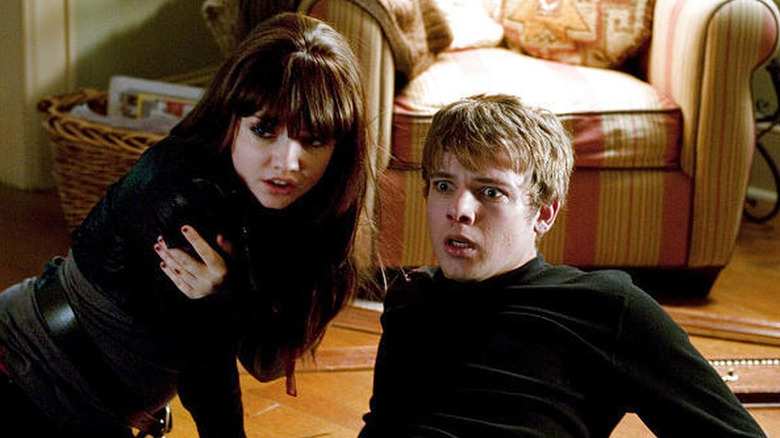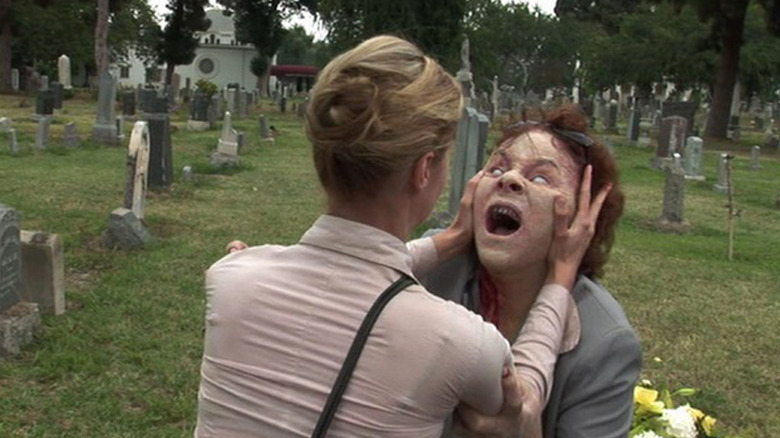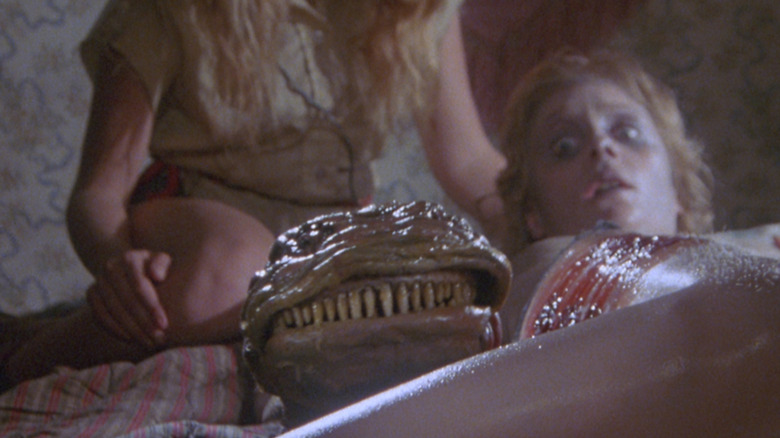3D Moments That Made These Horror Movies More Hilarious Than Terrifying
It's no secret that 3D just doesn't work in horror movies. Often considered a wacky gimmick, the addition of 3D to a serious horror flick doesn't just do nothing — it actively works against the film's efforts to build tension and atmosphere.
Why doesn't 3D work in horror movies? Well, as a big-screen spectacle, it often undercuts what a horror film should be all about: heightened emotions. Whether it's the pop-out circular saws of "Saw 3D" or the weird 3D specters of "Amityville 3D," the technology just doesn't seem to fit with the fright factor. In fact, it often pulls the audience out of the moment, forcing us to experience some weird detail in eye-popping 3D instead of soaking in the moment or enjoying the terror of a good jump scare.
When you look at the horror flicks that have used 3D, it's no wonder we didn't exactly buy it. Let's put it this way: there's no way any of these films could be mistaken for the best horror movies ever made. But thanks to these 3D moments, they do at least have a dose of comedy.
JAWS 3-D (1983)
That's right, it's the infamous "Jaws 3-D." Not only a terrible 3D film, but also one that managed to single-handedly destroy the "Jaws" franchise. It was the worst of all the "Jaws" sequels ... at least, until "Jaws: The Revenge" came along.
In "Jaws 3D," a great white shark finds itself trapped in SeaWorld Orlando after following a trio of water skiers into the park. And yet even as all hell breaks loose around them, the park management is hell-bent on capitalizing on this new development. It's as terrible as it sounds, with effects to match, particularly in the movie's final scenes.
After trying to flush out the shark, Mike Brody (Dennis Quaid) and the gang head back to the SeaWorld Control Room, but it seems the shark has appeared in front of its conspicuously flimsy glass viewing window and smashed through the glass! It sounds far more terrifying than it is, as the film's 3D effects turn this otherwise mediocre scene into a moment of sheer hilarity.
Honestly, I can't believe this ever made it to the big screen. Sure, there are plenty of atrocious 3D moments throughout the film, but given that this is the film's climax, you'd think a bit more care would be put into getting it right. Instead, the scene is assembled with what I can only assume is the least amount of effort possible, culminating in a truly un-terrifying scene with a shark that looks like a cardboard cut-out, complete with a weird black outline and a glass-shattering effect that looks like a '90s PowerPoint transition.
Friday the 13th Part III 3D (1982)
It's the film that gave Jason his iconic hockey mask, but "Friday the 13th Part III 3D" doesn't have much else going for it. Unfortunately, it's even worse when you take a closer look at some of the film's completely unnecessary 3D effects.
At various points throughout the film, we're treated to scenes of popcorn popping in glorious 3D, as well as, uh, a yo-yo going up and down? There's even one terrifying scene depicting a wallet being thrown toward the audience. Spooky!
The 3D moments run rampant in "Friday the 13th Part III 3D" with head-scratching regularity. And while some of the more brutal 3D scenes look okay, it seems that the filmmakers were more interested in the film's effects than its actor's performances. Larry Zerner, who played Shelly in the film, explained:
"It quickly became clear that most of the time, the performances didn't matter. When we were shooting the scene at the convenience store with the gang members and I had to throw a wallet at the camera, it was, 'Hit the camera!' Then, after ten takes it was 'Hit the camera, a**hole!'"
The result is an obvious focus on the effectiveness of the 3D scenes, most of which are peppered randomly throughout the movie with no real care about whether or not they heighten the terror. Instead it's reduced to a mere gimmick, with the most mundane of actions brought to the foreground in full 3D.
But there is one memorable moment when 3D is used to "enhance" the brutal horror. It comes when Jason crushes Rick's head with his bare hands, and his eyeball hilariously pops out at the audience. Behold: cinema!
The Final Destination (2009)
You can't cheat death ... but you can make it look even more eye-popping. "The Final Destination" is the franchise's first foray into 3D effects, and it sadly doesn't quite nail it. Sure, there's some fun to be had with its pop-out visuals, especially during the McKinley Speedway scenes, but the problem here is that the effects largely undermine the film's tension. In fact, I'd say they do away with it completely. Instead, the 3D scenes give the film a campy, schlocky quality that the series had previously avoided, if only by a narrow margin.
Producer Craig Perry said that he wanted the 3D to add depth to the film rather than just being used for the sake of it, because "having something pop out at the audience every four minutes gets boring." Unfortunately, that's exactly what happened, with all manner of objects and flying body parts shooting out of the screen with tired regularity.
The film's worst offender? That Speedway scene. It begins when a race car crash causes a tire to bounce into the spectator's stand — zooming right past the audience's eye line, of course. But that's just the beginning. We get several minutes of exploding cars, sharp objects, and visceral splatter, all in glorious 3D. While upping the ante when it comes to the gore, it just feels over the top. Throw in those 3D effects and some straight-to-DVD quality visuals, and it becomes a lesson in how not to use 3D in a horror film.
Although "Final Destination 5" continued to use 3D effects, it was a much better film. The sequel veered away from "The Final Destination's" campy antics, returning to the franchise's signature style of heightened suspense. Death was back, in 3D, and it never looked better.
Freddy's Dead: The Final Nightmare (1991)
Now, this is a weird one. The majority of "Freddy's Dead: The Final Nightmare" isn't in 3D. But the film's final act takes a very meta swerve into 3D as its main character, Maggie (Liza Zane) pops on a pair of 3D glasses. The result is a 3D "Freddyvision" sequence that boggles the mind.
Entering into Freddy's mind by putting on the glasses, Maggie witnesses a collection of Freddy's memories: all the things that led to him becoming an immortal killer and stalker of dreams. It's an altogether weird ending, made even weirder by the fact that there's not much that really needs 3D during this sequence. We find out that Freddy was teased as a child, that he was abused by his foster father, that he self-harmed as a teen, and eventually murdered his wife as an adult.
This trip through Freddy's history didn't need the gimmick of 3D. "A Nightmare on Elm Street" fans were already sold on finding out more about Freddy's past, and these scenes really do give us a view into the killer's psyche that we've never seen before. In fact, they're some of the most compelling scenes of the entire movie, making the addition of 3D effects a real head-scratcher. Of course, the real transgressions come as we're heading into Freddy's brain, complete with 3D disembodied floating skulls circling around us.
Quite what possessed the filmmakers to go in this direction is an absolute mystery, but what follows is a solid history of Freddy Krueger that fans of the series will really dig — if they can get past the very cheesy 3D effects, that is. An extra shout-out goes to Freddy's synapses for looking like a mass of long modeling balloons you'd expect to find at a children's party.
SAW 3D (2010)
If any of these films were made for 3D, it's obviously the "Saw" movie, right? "Saw 3D" takes the increasingly gory premise of the "Saw" franchise and amps it up to 11 with a variety of bloody, gory traps that make the most of its 3D format.
Shot entirely in 3D, the film latches onto the 2010s' obsession with 3D movies, rendering all manner of objects, weapons, and human viscera in extreme detail as they fly out of the screen. And one of the worst offenders is that DIY store scene.
In the gory opening setpiece of a truly wild sequel, "Saw 3D" features one of the most bizarre traps we've seen to date. Brad and Ryan have been seeing the same woman, and they find themselves shackled to opposite ends of a workbench with their mutual acquaintance, Dina, suspended over them. With a ticking clock and a trio of circular saws, the pair must decide who lives and who dies. Set up in the window of a home improvement store, it's a modern day, slightly gorier edition of "Jerry Springer."
The idea that any Jigsaw killer would care about a random love triangle is pretty ridiculous, but not as much as the 3D effects themselves. First-person shots of the circular saws plunging towards the audience are crying out for the 3D treatment, but where the film aims to make us experience what it's like to be inside one of Jigsaw's traps, it just comes off as a thoroughly unscary gimmick. Throw in the 3D spatter of Dina's innards and we have a horrible and laughably bad scene that will make you wish every "Saw" film was as good as the first.
Still, you can almost respect the decision to try something new. Almost.
Amityville 3-D (1983)
Now, this is one 3D horror film that makes absolutely no sense at all. "Amityville 3-D" came along around the same time as "Jaws 3-D" and "Friday the 13th Part III 3D" during the resurgence of 3D film in the early '80s. The trouble is ... "Amityville 3-D" has no business being a 3D film.
A classic haunted house kind of movie, "Amityville 3-D" is just about the worst possible kind of movie to try out those new-fangled 3D effects. It's essentially a sequel to "The Amityville Horror," even if it isn't exactly marketed as one.
Journalist John Baxter (Tony Roberts) moves into the infamous 112 Ocean Avenue, the now-iconic haunted house from the first film. But where previous installments took a more subtle approach to the supernatural, it's no surprise to find that "Amityville 3-D" is a bit more in your face.
Horrific visions are rendered in 3D space as John and his family encounter demons in their new home. The 3D effects add nothing, as you might imagine, to the usual haunted house tropes, and an altogether cheesy finale sees flying and exploding objects taking out paranormal investigators. The accidental comedy of the effects pulls us out of the film entirely as the whole thing devolves into farce. There's really no redeeming feature when it comes to this film's 3D, with the finale acting as a reminder of why the first movie was so terrifying: it's everything "Amityville 3-D" isn't.
The house imploding is a neat metaphor for the movie itself, a box office flop that was widely panned upon its release. In fact, the franchise wouldn't return to theaters until 2005. Quite the legacy for a bona fide 3D nightmare.
My Soul to Take (2010)
I hate to speak ill of a horror legend, but Wes Craven's "My Soul to Take" is just terrible. It tells the story of seven teenagers who have been chosen to die on the anniversary of a serial killer's death. Why? It's believed that they might possess parts of his soul, since the killer had Dissociative Identity Disorder.
Honestly, there's not much that could save this one. A dull, lifeless script is hashed out half-heartedly across the film's 107-minute runtime, with formulaic story beats that really aren't helped at all by the lackluster 3D effects. "My Soul to Take" wasn't even shot in 3D; it was converted in post-production to capitalize on the rising popularity of 3D films.
The 3D effects go relatively unnoticed, which is sort of a blessing. After all, the film never distracts from the atmosphere with eye-popping visuals. But it also does little to justify a 3D conversion in the first place. Sure, there are some moments that look quite neat; one particular shot looking through a slatted closet door makes for an interesting discussion of immersive 3D techniques. But since it lasts no more than a few seconds, it's not really worth the hassle of converting to 3D, and the movie was never originally intended to be presented that way at all.
"It was done totally as a 2D film, we never thought of 3D," said Craven at the time. "They approached me, and said, 'How about 3D? We would love to do it in 3D.'"
The most frustrating thing about "My Soul to Take" is that it was Wes Craven's final film. Instead of going out on a high note, the legendary horror filmmaker crossed the finish line with a film that's just a dull, withering mess. And no amount of 3D effects was going to make that any better.
Night of the Living Dead 3D (2006)
A remake of George Romero's 1968 horror classic, "Night of the Living Dead 3D" is the one we wish hadn't been made. It's a bland rehash of the original, made with absolutely no input from Romero or anyone else who was involved with "Night of the Living Dead."
The result? An absolutely shocking adaptation of a real classic. It's very clearly a cynical cash-in, and even an appearance from Sid Haig can't save "Night of the Living Dead 3D" from itself. The film is devoid of any artistic merit of its own, relying solely on its association with the original film to dupe the audience into thinking this might be an decent horror flick. Spoiler: it isn't.
As for the 3D aspect, it adds very little, but that's not really surprising. Based on old-school stereoscopic tech that required the red and blue anaglyph 3D glasses, its retro styling might seem cute at first, but even as a gimmick the 3D adds nothing to this lifeless retread. "Night of the Living Dead 3D" opens with a shot of the original movie playing on TV ... and that's about as good as it gets.
There are several moments that were clearly designed to capitalize on the 3D effect, with POV shots giving us a zombie's-eye-view of getting nailed by survivors in a variety of different ways. But the anaglyph 3D really loses its charm when you consider the film was made in 2006. Even 3D films of the '50s managed to use the tech in more innovative ways.
Parasite (1982)
No, no that "Parasite." This one is the 1982 sci-fi horror flick starring Demi Moore in her first major film role. "Parasite" tells the story of Dr. Paul Dean (Robert Glaudini), a scientist who has created a new life form for an organization known as the Merchants, who are basically in charge of a post-apocalyptic America. Escaping the group and fleeing across the country, Dr. Dean is looking for a way to destroy the parasite. That's when he's helped by a young lemon grower (???) played by Demi Moore.
It's a slow, plodding slog in between camp scenes of utter movie carnage. Even Moore herself identified "Parasite 3D" as the worst movie she's ever been in. There's really not much more to be said. It absolutely is the worst Demi Moore film, with plenty of cheesy lines, terrible acting, and some incredibly low-fi effects. The 3D scenes are infrequent and, at best, a mild distraction from the rest of the film's flaws.
Even then, they're not really up to scratch. One of the better 3D moments sees the parasite bursting from the body of one of its victims. But "Alien" it ain't. The worst offender is undoubtedly a long, slow zoom-in to a body impaled on a pipe, with the pipe leaning out towards the audience in gloriously gory 3D.
